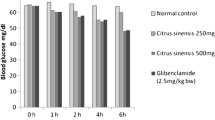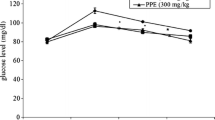Abstract
The hitherto unknown glucose regulating role of three vegetable peels from cucurbitaceae family was evaluated. In a preliminary study, effects of ethanolic extracts of Cucurbita pepo, Cucumis sativus and Praecitrullus fistulosus peels were studied at 250 and 500 mg kg−1 d−1 for 15 days in the alterations in serum glucose and in hepatic lipid peroxidation (LPO) in male mice. In the pilot experiment, the effective and safe concentration of each peel was administered (p.o.) for 10 consecutive days and then on 11th and 12th days alloxan was administered along with peel extracts. The treatment was continued up to 15th day. At the end, alterations in serum glucose, insulin, triiodothyronine, thyroxine, total cholesterol, triglyceride, high density lipoprotein, low density lipoprotein, very low density lipoprotein, hepatic lipid peroxidation, superoxide dismutase and catalase were studied. All the three peel extracts nearly reversed most of these changes induced by alloxan suggesting their possible role in ameliorating diabetes mellitus and related changes in serum lipids. However, Cucurbita pepo peel was found to be the most effective. Total polyphenols, flavonoids and ascorbic acid contents of the test peels were also estimated, which appear to be associated with the observed antidiabetic and antioxidative potentials.


Similar content being viewed by others
Abbreviations
- LPO:
-
Lipid peroxidation—oxidative degradation of lipids
- SOD:
-
Superoxide dismutase—an endogenous antioxidant
- CAT:
-
Catalase—an endogenous antioxidant
- TBA:
-
Thiobarbituric acid—a chemical that reacts with malondialdehyde
- TCA:
-
Tricarboxylic acid—a chemical that precipitates protein
References
Yoshino G, Hirano T, Kazumi T (1996) Dyslipidemia in diabetes mellitus. Diab Res Clin Pract 33:1–14
Rang HP, Dale MM (1991) The endocrine system. Pharmacology, 2nd edn. Harlow, Longman, p 504
Scartezzini P, Speroni E (2000) Review on some plants of the Indian traditional medicine with antioxidant activity. J Ethnopharmacol 71:23–43
Kar A, Panda S (2004) Ayurvedic therapies for thyroid dysfunction. In: Mishra L (ed) Scientific Basis of Ayurvedic Therapies, Chapter 8. CRC Press, FL
Atawodi SE (2005) Antioxidant potential of African medicinal plants. Afr J Biotechnol 4:128–133
Shetty AK, Kumar GS, Sambaiah K, Salimath PV (2005) Effect of bitter gourd (Momordica charantia) on glycaemic status in streptozotocin induced diabetic rats. Plant Foods Hum Nutr 60:109–112
Larson RA (1988) The antioxidants of higher plants. Phytochem 27:969–978
Parmar HS, Kar A (2007) Antidiabetic potential of Citrus sinensis and Punica granatum peel extracts in alloxan treated male mice. Biofactors 31:17–24
Parmar HS, Kar A (2007) Protective role of Citrus sinensis, Punica granatum and Musa paradisiaca peels against diet induced atherosclerosis. Nutr Res 27:710–718
Parmar HS, Kar A (2008) Possible amelioration of atherogenic diet induced dyslipidemia, hypothyroidism and hyperglycemia by the peel extracts of Mangifera indica, Cucumis melo and Citrullus vulgaris fruits in rats. Biofactors 33:13–24
Parmar HS, Kar A (2008) Antiperoxidative, antithyroidal, antihyperglycemic and cardioprotective role of Citrus sinensis peel extract in male mice. Phytother Res 22:791–795
Dixit Y, Panda S, Kar A (2008) Lagenaria siceraria peel extract in the regulation of hyperthyroidism, hyperglycemia and lipid peroxidation in mice. Int J Biomed Pharma Sci 2:79–83
Dixit Y, Kar A (2009) Antioxidative activity of some vegetable peels determined in vitro by inducing liver lipid peroxidation. Food Res Int 42:1351–1354
Singh N, Rajini PS (2005) Protective effect of potato peel powder in ameliorating oxidative stress in streptozotocin diabetic rats. Plant Foods Hum Nutr 60:49–54
Park J, Kim J, Kim MK (2007) Onion flesh and onion peel enhance antioxidant status in aged rats. J Nutr Sci Vitaminol 53:21–29
Leontowicz M, Gorinstein S, Leontowicz H, Krzeminski R, Lojek A, Katrich E, Ciz M, Martin-Belloso O, Soliva-Fortuny R, Haruenkit R, Trakhtenberg S (2003) Apple and pear peel and pulp and their influence on plasma lipids and antioxidant potentials in rats fed with cholesterol-containing diets. J Agric Food Chem 51:5780–5785
Omaye ST, Turbull JD, Sauberlich HE (1979) Selected methods for the determination of ascorbic acid in animal cells, tissues and fluids. Meth Enzymol 62:3–11
Xia T, Wang Q (2006) Antihyperglycemic effect of Cucurbita ficifolia fruit extract in streptozotocin induced diabeteic rats. Fitoterapia 77:530–533
Chandrashekhar B, Mukherjee B, Mukherjee SK (1989) Blood sugar lowering potential of selected cucurbitaceae plants of Indian origin. Indian J Med Res 90:300–305
Raskovic A, Gavrilovic M, Jakovljevic V, Sabo J (2004) Glucose concentration in the blood of intact and alloxan-treated mice after pretreatment with commercial preparations of Stevia rebaudiana (Bertoni). Eur J Drug Metab Pharmacokinet 29:87–90
Panda S, Kar A (2007) Antidiabetic and antioxidative effects of Annona squamosa leaves are possibly mediated through quercetin-3-O-glucoside. Biofactors 31:201–210
Jatwa R, Parmar HS, Panda S, Kar A (2007) Amelioration of corticosteroid-induced type 2 diabetes mellitus by rosiglitazone is possibly mediated through stimulation of thyroid function and inhibition of tissue lipid peroxidation in mice. Basic Clin Pharmacol Toxicol 101:177–180
Ohkawa H, Ohishi N, Yagi K (1979) Assay for lipid peroxides in animal tissues by thiobarbituric reaction. Anal Biochem 95:351–358
Marklund S, Marklund G (1974) Involvement of superoxide anion radical in antioxidation of pyrogallol and a convenient assay of superoxide dismutase. Eur J Biochem 47:469–474
Aebi HE (1983) Catalase. In: Bergmeyer HU (ed) Methods in Enzymatic Analysis (Vol III). Academic Press, New York, pp 276–286
Lowry OH, Rosebrough NJ, Farr AL, Randall RJ (1951) Protein measurement with the Folin-phenol reagent. J Biol Chem 193:265–275
Trinder P (1969) Practical Clinical Biochemistry (Vol X), 5th edn. William Heinamman Medical books LTD, New York
Parmar HS, Kar A (2007) Atherogenic diet induced diabetes mellitus: involvement of thyroid hormones. Eur J Pharmacol 570:244–248
Parmar HS, Kar A (2009) Protective role of Mangifera indica, Cucumis melo and Citrullus vulgaris peel extracts in chemically induced hypothyroidism. Chem Biol Interact 177:254–258
Rerup CC (1970) Drugs producing diabetes through damage of insulin secreting cells. Pharmacol Rev 22:485–520
Yallow RS, Black H, Villazan M, Berson SA (1960) Comparison of plasma insulin levels following administration of tolbutamide and glucose. Diabetes 9:356–362
Grodsky GM, Epstein GH, Fanska R, Karam JH (1971) Pancreatic action of sulphonylureas. Fed Proc 36:2719–2728
Gray M, Flatt PR (1999) Insulin-secreting activity of the traditional antidiabetic plant Viscum album (mistletoe). J Endocrinol 160:409–414
Parmar HS, Kar A (2008) Medicinal values of fruit peels from Citrus sinensis, Punica granatum, and Musa paradisiaca with respect to alterations in tissue lipid peroxidation and serum concentration of glucose, insulin and thyroid hormones. J Med Food 11:376–381
Parmar HS, Panda S, Jatwa R, Kar A (2006) Cardio-protective role of Terminalia arjuna bark extract is possibly mediated through alterations in thyroid hormones. Pharmazie 61:793–795
Szkudelski T (2001) The mechanism of alloxan and streptozotocin action in B cells of the rat pancreas. Physiol Res 50:537–546
Iqbal MP, Kazim SF, Mehboobali N (2006) Ascorbic acid contents of Pakistani fruits and vegetables. Pak J Pharm Sci 19:282–285
Marinova D, Ribarova F, Atanassova M (2005) Total phenolics and total flavonoids in Bulgarian fruits and vegetables. J Univ Chem Technol Metallurgy 40:255–260
Acknowledgements
Financial support from the University Grant Commission, N. Delhi, India to Ms. Yamini Dixit is gratefully acknowledged. Some help from Dr. S. Panda and Dr. H. S. Parmar is also appreciated.
Author information
Authors and Affiliations
Corresponding author
Rights and permissions
About this article
Cite this article
Dixit, Y., Kar, A. Protective Role of Three Vegetable Peels in Alloxan Induced Diabetes Mellitus in Male Mice. Plant Foods Hum Nutr 65, 284–289 (2010). https://doi.org/10.1007/s11130-010-0175-3
Published:
Issue Date:
DOI: https://doi.org/10.1007/s11130-010-0175-3




